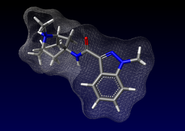Granisetron
 | |
 | |
| Clinical data | |
|---|---|
| Trade names | Kytril, Sancuso, others |
| AHFS/Drugs.com | Monograph |
| MedlinePlus | a601211 |
| License data | |
| Pregnancy category |
|
intravenous, transdermal | |
| ATC code | |
| Legal status | |
| Legal status | |
| Pharmacokinetic data | |
| Bioavailability | 60% |
| Protein binding | 65% |
| Metabolism | Hepatic |
| Elimination half-life | 3–14 hours |
| Excretion | Renal 11–12%, faecal 38% |
| Identifiers | |
| |
JSmol) | |
| |
| |
| | |
Granisetron is a
Granisetron was developed by chemists working at the British drug company
A granisetron transdermal patch with the trade name Sancuso was approved by the US FDA on September 12, 2008.[1] Sancuso is manufactured by 3M Drug Delivery Systems for Kyowa Kirin, Inc.
It was patented in 1985 and approved for medical use in 1991.[2] It is on the World Health Organization's List of Essential Medicines.[3]
Medical uses
Chemotherapy
It may be used for chemotherapy-induced nausea and vomiting and appears to work about the same as ondansetron.[4] The most common side-effects of chemotherapy treatment are nausea, vomiting and diarrhea. This is one type of drug that a doctor can prescribe to prevent, lessen, or relieve discomfort.[citation needed]
Post operative
A number of medications including granisetron appear to be effective in controlling
Gastroparesis
The granisetron patch (Sancuso) has been studied for use in gastroparesis,[7] though it is not FDA approved for this indication.[8]
Other
- Is a possible therapy for nausea and vomiting due to acute or chronic medical illness or acute gastroenteritis[citation needed]
- Treatment of cyclic vomiting syndrome although there are no formal trials to confirm efficacy.[citation needed]
Adverse effects
Granisetron is a well-tolerated drug with few side effects. Headache, dizziness, and constipation are the most commonly reported side effects associated with its use. There have been no significant drug interactions reported with this drug's use. It is broken down by the liver's cytochrome P450 system and it has little effect on the metabolism of other drugs broken down by this system.[citation needed]
Extended release
An extended release injectable version of granisetron, known as Sustol is also available in the United States as of 2016.[9] The long acting form is used for the treatment of both acute and delayed CINV in moderately emetogenic chemotherapy and anthrocycline and/or cyclophosphamide (AC) highly emetogenic regimens. In its review, the FDA did not grant the broad HEC label to the drug citing the focus on AC regimens, primarily breast-cancer, and lack of data.[10]
References
- ^ "FDA Approves Sancuso, the First and Only Patch for Preventing Nausea and Vomiting in Cancer Patients Undergoing Chemotherapy". PRNewswire. September 12, 2008.
- ISBN 9783527607495.
- hdl:10665/345533. WHO/MHP/HPS/EML/2021.02.
- )
- PMID 31333369.
- )
- PMID 27400689.
- ^ "Sancuso Full Prescribing Information" (PDF). U.S. Food and Drug Administration. September 2015. Retrieved November 29, 2019.
- ^ Drugs.com Heron Therapeutics Announces FDA Approval of Sustol (granisetron) Extended-Release Injection for the Prevention of Chemotherapy-Induced Nausea and Vomiting
- ^ FDA.gov Sustol Prescribing Information.
Further reading
- Aapro M (2004). "Granisetron: an update on its clinical use in the management of nausea and vomiting". The Oncologist. 9 (6): 673–86. PMID 15561811.
